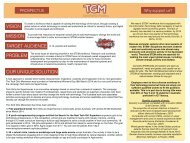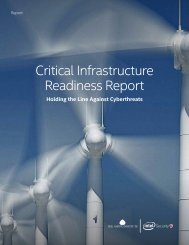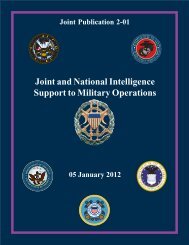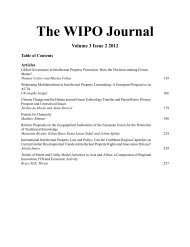Transparency Initiative (EITI)
2eoch1l
2eoch1l
You also want an ePaper? Increase the reach of your titles
YUMPU automatically turns print PDFs into web optimized ePapers that Google loves.
77<br />
9.2 RESULTS MODEL<br />
To shed light on the links between activities of M-<strong>EITI</strong> towards<br />
improved transparency, accountability, and aggregated<br />
impacts, the reconstruction of the theory of change<br />
started with an analysis of the MSG’s work plan. The 2013-<br />
2015 work plan sets this goal for M-<strong>EITI</strong>: ‘Promote and<br />
strengthen good governance through transparency, accountability,<br />
participation and sustainable exploration of<br />
extractive resources’, with objectives that are procedural in<br />
nature leading to producing a comprehensive report, accompanied<br />
with training and communication activities.<br />
The second part of the goal, ‘sustainable exploration of extractive<br />
resources’ was not clearly defined and it is not clear<br />
what processes will guarantee its compliance. The 2016-<br />
2018 work plan appears to be a much better structured plan<br />
with clear objectives and a path to achieve them, but it does<br />
not make a distinction between outputs and outcomes and<br />
is lacking outcome indicators for adequate monitoring. Finally,<br />
a couple of areas that are not adequately covered in<br />
the M-<strong>EITI</strong> work plan have been discussed in the course of<br />
the study and included in the results model. These areas are<br />
local content and revenue redistribution (current and for<br />
future generations).<br />
COUNTRY-SPECIFIC RESULTS MODEL (DRAFT IN PROGRESS AS<br />
DISCUSSED WITH MSG MEMBERS IN JULY 2016)<br />
Levels Areas Indicators<br />
(in addition to the ones listed in the generic<br />
model)<br />
Conditions<br />
(conducive/obstructive)<br />
Highly<br />
aggregated<br />
impact<br />
Sustainable development in<br />
Mozambique<br />
• Poverty reduction<br />
• Economic diversification<br />
• Economic growth<br />
1. USD X income per capita<br />
2. USD X income per capita in regions of EI<br />
influence.<br />
3. X% of population below the poverty level<br />
4. GINI coefficient<br />
Same as in generic model.<br />
Specifically:<br />
1. Political will to establish<br />
a peaceful solution<br />
to conflict.<br />
2. Macroeconomic conditions<br />
substantially improved<br />
with a sound<br />
fiscal program accepted<br />
by IMF and donors implemented.<br />
3. Capacity of key government<br />
agencies to manage<br />
the EI sector – including<br />
monitoring of<br />
contracts – improved.<br />
4. Favorable fiscal terms.









